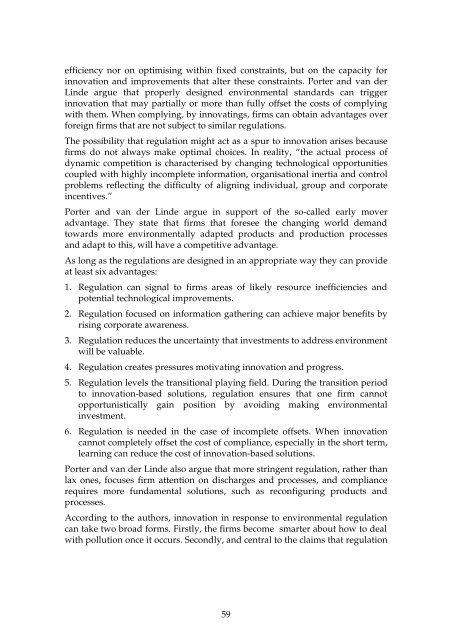Drivers of environmental innovation - Vinnova
Drivers of environmental innovation - Vinnova
Drivers of environmental innovation - Vinnova
Create successful ePaper yourself
Turn your PDF publications into a flip-book with our unique Google optimized e-Paper software.
efficiency nor on optimising within fixed constraints, but on the capacity for<br />
<strong>innovation</strong> and improvements that alter these constraints. Porter and van der<br />
Linde argue that properly designed <strong>environmental</strong> standards can trigger<br />
<strong>innovation</strong> that may partially or more than fully <strong>of</strong>fset the costs <strong>of</strong> complying<br />
with them. When complying, by innovatings, firms can obtain advantages over<br />
foreign firms that are not subject to similar regulations.<br />
The possibility that regulation might act as a spur to <strong>innovation</strong> arises because<br />
firms do not always make optimal choices. In reality, “the actual process <strong>of</strong><br />
dynamic competition is characterised by changing technological opportunities<br />
coupled with highly incomplete information, organisational inertia and control<br />
problems reflecting the difficulty <strong>of</strong> aligning individual, group and corporate<br />
incentives.”<br />
Porter and van der Linde argue in support <strong>of</strong> the so-called early mover<br />
advantage. They state that firms that foresee the changing world demand<br />
towards more <strong>environmental</strong>ly adapted products and production processes<br />
and adapt to this, will have a competitive advantage.<br />
As long as the regulations are designed in an appropriate way they can provide<br />
at least six advantages:<br />
1. Regulation can signal to firms areas <strong>of</strong> likely resource inefficiencies and<br />
potential technological improvements.<br />
2. Regulation focused on information gathering can achieve major benefits by<br />
rising corporate awareness.<br />
3. Regulation reduces the uncertainty that investments to address environment<br />
will be valuable.<br />
4. Regulation creates pressures motivating <strong>innovation</strong> and progress.<br />
5. Regulation levels the transitional playing field. During the transition period<br />
to <strong>innovation</strong>-based solutions, regulation ensures that one firm cannot<br />
opportunistically gain position by avoiding making <strong>environmental</strong><br />
investment.<br />
6. Regulation is needed in the case <strong>of</strong> incomplete <strong>of</strong>fsets. When <strong>innovation</strong><br />
cannot completely <strong>of</strong>fset the cost <strong>of</strong> compliance, especially in the short term,<br />
learning can reduce the cost <strong>of</strong> <strong>innovation</strong>-based solutions.<br />
Porter and van der Linde also argue that more stringent regulation, rather than<br />
lax ones, focuses firm attention on discharges and processes, and compliance<br />
requires more fundamental solutions, such as reconfiguring products and<br />
processes.<br />
According to the authors, <strong>innovation</strong> in response to <strong>environmental</strong> regulation<br />
can take two broad forms. Firstly, the firms become smarter about how to deal<br />
with pollution once it occurs. Secondly, and central to the claims that regulation<br />
59

















